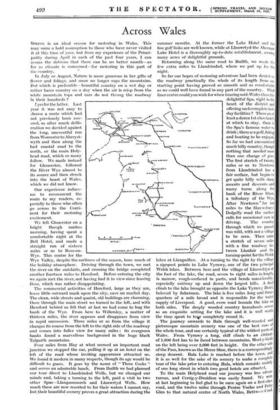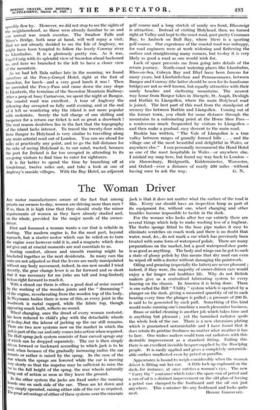Across Wales
SPRING is an ideal season for motoring in Wales. This may seem a bold assumption to those who have never visited it at this time of year, but from my experience of the Princi- pality during April in each of the past four years, I can assure the dubious that there can be no better month—as far as climate is concerned—for motoring in this part of the country.
- In July or August, Nature is more generous in her gifts of flower and foliage, and snow no longer caps the mountains. But which is preferable—beautiful country on a wet day or rather barer country on a day when the air is crisp from the white mountain tops and cars do not throng the roadway in their huhdreds ?
I prefer the latter. Last year it was not easy to 'choose a route which had not previously been cov- ered, so after much delib- eration we decided against the long, uneventful run from Worcester to Aberyst- wyth and then along the bad coastal road to the north, or the main Holy- head road, which so many follow. We made instead for Gloucester, followed the River Wye almost to its source and then struck into the heart of Wales, which we did not know.
Our experience induces me to recommend the route to my readers, es- pecially to those who often ga across to the Conti- nent for their motoring excitement.
We left Gloucester on a bright though sunless morning, having spent a comfortable night at the Bell Hotel, and made a straight run of sixteen miles or so to Ross-on- Wye. This centre for the Wye Valley, despite the earliness of the season, bore much of the holiday atmosphere. Driving through the town, we met the river on the outskirts, and_ crossing the bridge completed another fourteen miles to Hereford. Before entering the city we again met the river, not having had it in view since leaving Ross, which was rather disappointing.
The commercial activities of Hereford, large as they are, leave little outward mark upon the city, save on market day. The clean, wide streets and quaint, old buildings are charming. Once through the main street we turned to the left, and with Hereford behind us felt that at last we had come to hug the bank of the Wye. From here to Willersley, a matter of thirteen miles, the river appears and disappears from view in rapid succession. Three miles or so from the village it changes its course from the left to the right side of the roadway and comes into fuller view for many miles : its evergreen banks found a marvellous background in the huge black Talgarth mountains.
Four miles from Hay at what seemed an important road junction we stopped the car, pulling it up at an hotel on the left of the road whose inviting appearance attracted us. We found it modern in many respects, though its age would be difficult to guess. It goes by the name of " Three Cocks and serves an admirable lunch, From Builth we had planned our tour direct to Llandrindod Wells, but we changed our minds 'and, taking a turning to the left, paid a visit to two other Spas—Llangammarch and Llanwrtyd Wells. How much these are now resorted to for their waters I cannot say, buttheir beautiful scenery proves a great attraction during the summer months. . At the former the Lake Hotel and the fine golf links are well known, while at Llanwrtyd the Abernant Lake Hotel is a thoroughly up-to-date establishment, owning many acres of delightful groundi.
Returning along the same road to Builth, we made the few extra miles to Llandrindod, where we put up for the night.
nothing that needed more than one change of gear, The first stretch of twenty miles or so to Newtown from Llandrindod has a fair surface, but begins to get quite hilly with sharp ascents and descents and many turns along the bank of the River Ithon, a tributary of the Wye, After Newtown • for ten miles to the Shrewsbury.
Dolgelly road the surface calls for occasional care in driving. The country through which we passed was wild, with not a village
to be seen. Then came a stretch of seven miles with a fine roadway be. tween Llanfair and the turning-point forthe Welsh lakes at Llangadfan. At a turning to the right by the village a signpost points to Lake Vyrnwy, one of the two principal Welsh lakes. Between here and the village of LLanwddyn at the foot of the lake, the road, seven to eight miles in length, is narrow, rough-surfaced in parts, and bends considerably, especially midway up and down the largest hills. A final climb to the lake brought us opposite the Lake VyrnwyHotel, beloved by fishermen. The lake is five miles long and three. quarters of a mile broad and is responsible for the water supply of Liverpool. A good, even road bounds the lake on both sides. The deeply wooded country hereabouts serves as an exquisite setting for the lake and it is well worth the time spent to to completely round it.
The journey onwards to Bala through well-wooded and picturesque mountain scenery was one of the best runs of the whole tour, and one certainly typical of the wildest parts of Wales. From Vyrnwy a long, stiff climb to an altitude of.1,600 feet has to be faced between mountains, Moel-y-Gegt on the left being over 2,000 feet in height. On the other side of the Pass, known as the Horse Shoe, there is a correspondingly steep descent. Bala Lake is reached before the town, and it is as well for the sake of its scenery to make a complete tour of the lake prior to entering Bala, which consists mainly of one long street in which two good hotels are situated.
To the main Holyhead road our journey was less adven. turous, and Cerrig-y-Druidion was easily found: We were at last beginning to feel glad to be once again on a first-clao road, and the twelve miles through Pentre Voelas and Fail Glen to that natural centre of North Wales, Bettws-V-04 speedily flew by. However, we did not stop to see the sights of the neighbourhood, as these were already familiar to us and our arrival was much overdue. The Swallow Falls and Miner's Bridge, both near at hand, will well repay a visit. Had we not already decided to see the Isle of Anglesey, we might have been -tempted to follow the lovely Conway river to Llandudno. It is a gloriously pretty run. As it was, Capel Curig with its splendid view of Snowdon ahead beckoned us, and here we branched to the left to have a closer view of the mountain.
As we had left Bala rather late in the morning, we found ourselves at the Pen-y-Gwryd Hotel, right at the foot of Snowdon, for lunch—and a very good lunch it was ! Then we ascended the Pen-y-Pass and came down the easy slope to Llanberis, the terminus of the Snowdon Mountain Railway. After a peep at busy Carnarvon, we spent the night at Bangor. The coastal road was excellent. A tour of Anglesey the following day occupied us fully until evening, and at the end of it left us wondering why the island is not more popular with motorists. Surely the toll charge of one shilling and twopence for a return car ticket is not so great a drawback ! The real reason doubtless lies in the fact that the topography of the island lacks interest. To travel the twenty-four miles from Bangor to Holyhead is very similar to travelling along any main arterial road out of London. You can see ahead for miles at practically any point, and to go the full distance for the sake of seeing Holyhead is, to our mind, wasted, because the port for Ireland is far too occupied in attending to its sea-going visitors to find time to cater for sightseers. .
It is fir better to spend the time by branching' off at Gwalchmai, twelve miles out, and take a look at one of Anglesey's seaside villages. With the Bay Hotel, an adjacent golf course and a long stretch of sandy sea front, Rhosneigr is attractive. Instead of visiting Holyhead, then, we turned right at Valley and kept to the coast road, past pretty Cemmacs Bay, to Amlwch on Bull Bay, where there is a sporting golf course. Our experience of the coastal road was unhappy, for road engineers were at work widening and flattening the surface and straightening many corners, but to-day it is very likely as good a road as one would wish for.
Lack of space prevents me from going into details of the return journey. North-coast watering places like Llandudno, Rhos-on-Sea, Colwyn Bay and Rhyl have been famous for many years, but Llanfairfechan and Penmacnmawr, between Bangor and Conway (the latter should be seen for its handsome bridge) arc not so well known, but equally attractive with their sandy beaches and sheltering mountains. The nearest way home from Bangor takes in Abergele, St. Asap'', Denbigh and Ruthin to Llangollen, where the main Holyhead road is joined. The best part of this road from the standpoint of scenery lies between Ruthin and Llangollen. Coming out of the former town, you climb for some distance through the mountains to a culminating point at the Horse Shoe Pass— a rendezvous much frequented by visitors to Llangollen— and then make a gradual, easy descent to the main road.
Ruskin has written, " The Vale of Llangollen is a true valley between ranges of grandly formed hills . . . and the village one of the most beautiful and delightful in Wales, or anywhere else." I can personally recommend the Hand Hotel as one of. the most hospitable in Wales—or anywhere else. I mislaid my map here, but found my way back to London— via Shrewsbury, Bridgnorth, Kidderminster, Worcester, and Oxford—over a distance of nearly 200 miles—without
having once to ask the way. G. N.































































 Previous page
Previous page